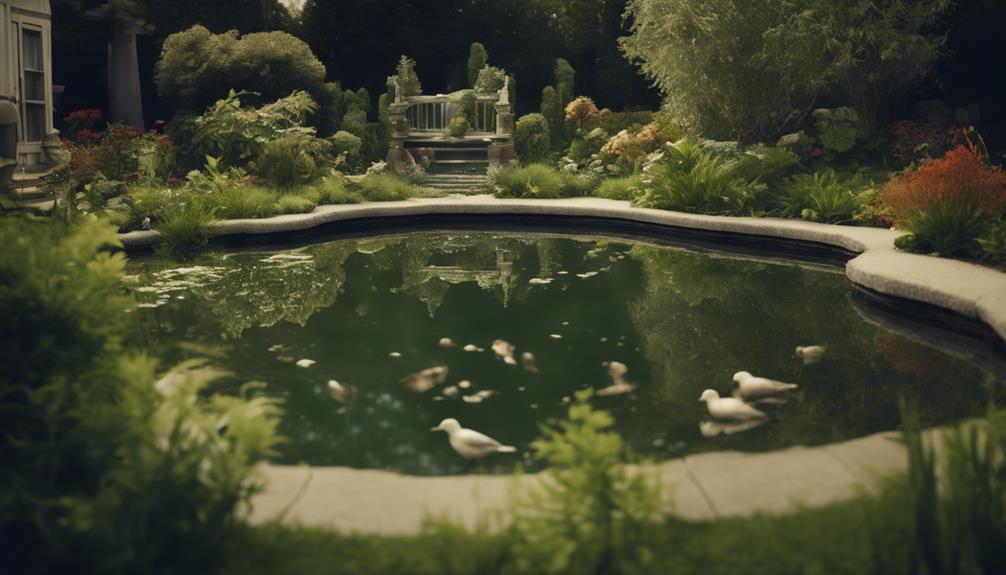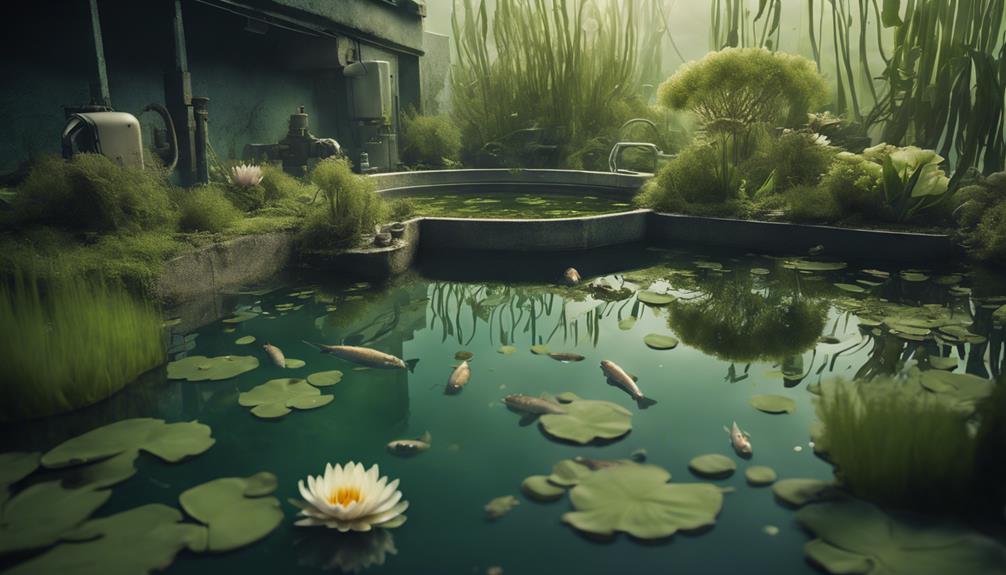You've tried various algae control methods in your garden pond, but they haven't worked. This is often due to a combination of misconceptions about algae growth, inadequate pond design and maintenance, and a lack of understanding of the underlying causes of algae proliferation. You might not have identified the type of algae, leading to applying the wrong control methods. Inadequate pond design, poor maintenance, and unaddressed nutrient sources can create an environment conducive to algae growth. Overreliance on quick fixes like UV clarifiers or algaecides can exacerbate the problem. To truly combat algae, you need to understand the root causes – and that's just the starting point.
Table of Contents
Key Takeaways
- Failure to identify the type of algae can lead to applying the wrong control methods, making the situation worse.
- Inadequate pond design and maintenance create an environment conducive to algae growth, rendering control methods ineffective.
- Relying solely on quick fixes like UV clarifiers or algaecides doesn't address the root causes of algae growth, leading to a vicious cycle.
- Ignoring nutrient sources around the pond, such as fertilizer applications and runoff, allows algae to regrow quickly despite control efforts.
- Neglecting ongoing pond monitoring and maintenance prevents detection of underlying issues, making it impossible to prevent algae growth.
Misunderstanding Algae Biology
Frequently, pond owners and managers misunderstand the biology of algae, which can lead to ineffective control methods and a perpetuation of the problem.
Algae growth is fueled by excess nutrients and sunlight, creating an ideal environment for these primitive plants to thrive.
There are different types of algae, each with unique characteristics. For instance, single-celled algae can pass through even the finest filter, while filamentous algae require clear, mineral-enriched waters with good light penetration to germinate.
Understanding these differences is vital to addressing algae problems effectively. If you don't identify the type of algae you're dealing with, you might apply the wrong control methods, making the situation worse.
Additionally, blue-green algae, which can produce toxins, have distinct requirements, such as phosphates, and can even fix their own nitrogen.
Inadequate Pond Design and Maintenance
Inadequate pond design and maintenance are often the underlying causes of algae growth, as a poorly constructed or neglected pond can create an environment conducive to algae proliferation.
You may not realize that your pond's design is inadequate, but it's vital to examine factors that contribute to algae growth. For instance, a small pond with a large waterfall can be more of a pump basin than a pond, leading to excessive algae.
The use of concrete in the pond's construction can also increase the pH level of the water and provide a surface for algae to attach to. Additionally, situating your pond in full sun can exacerbate algae growth by providing excessive sunlight for algae to thrive.
To prevent algae growth, you need to maintain a balanced pond ecosystem.
Regular cleaning, including partial refilling of the pond with clear water, is necessary to remove excess nutrients and algae. You should also monitor and adjust your pond's water quality regularly to prevent nutrient imbalances.
Failure to Address Nutrient Sources

When you're trying to control algae, you can't ignore the sources of excess nutrients that fuel their growth.
You'll need to identify and address the nutrient runoff sources, such as agricultural or urban runoff, that are contributing to the problem.
Additionally, you'll want to examine the inflow water, ensuring it's properly treated to prevent the introduction of excess nutrients into the system.
Nutrient Runoff Sources
Failure to address nutrient sources around your pond can have devastating consequences, as even a single pound of phosphorus from fertilizer applications or nutrient-rich runoff can produce a staggering 1,000 pounds of algae.
You mightn't realize that fertilizer applications around your pond can lead to nutrient buildup, contributing to algae growth. Similarly, nutrient-rich runoff from surrounding areas, such as lawns, fields, and septic tanks, can enter your pond, promoting algae growth.
These excess nutrients can come from various sources, including fertilizer applications and runoff from nearby areas. If you don't take steps to address these sources, you're basically fueling the growth of algae in your pond.
Recognizing the vital role these nutrient runoff sources play in algae growth and taking measures to mitigate their impact is crucial. By doing so, you can reduce the likelihood of algae blooms and create a healthier environment for your pond's ecosystem.
Untreated Inflow Water
As you allow untreated inflow water to enter your pond, you inadvertently introduce a torrent of excess nutrients that can sabotage even the most well-intentioned algae control methods.
These nutrients can stimulate algae growth, rendering your control efforts ineffective.
Crucial to tackle is the amount of nutrients entering your pond through inflow water, as it can be a significant contributor to algae blooms.
Nutrients from surrounding areas, such as fertilized lawns and fields, can enter your pond through runoff, fueling algae growth.
Inflow water can carry nutrients from septic tanks, leach fields, and animal feedlots, further exacerbating the issue.
Without proper treatment or diversion, these nutrient-laden waters can create an environment conducive to algae growth.
Failure to address nutrient sources in inflow water can lead to persistent algae blooms, despite your best control efforts.
Overreliance on Quick Fix Solutions
When you're dealing with an algae infestation, it's easy to fall into the trap of seeking quick fix solutions that promise immediate results.
However, this approach often stems from a lack of understanding about the underlying causes of algae growth and the potential long-term consequences of relying on chemical treatments.
As you explore the world of algae control, crucial to recognize is that effective management requires a deeper understanding of the ecosystem and a commitment to sustainable practices.
Lack of Understanding
Misconceptions about algae growth often lead you down a path of relying on quick fix solutions, which ultimately exacerbate the underlying ecosystem imbalance, rather than addressing the root causes of the problem.
You may think you're saving time and effort, but in reality, you're creating more harm than good.
Some harsh realities to ponder:
You're not addressing the root causes of algae growth, only its symptoms.
You're disrupting the delicate balance of your pond's ecosystem, making it more prone to future algae blooms.
You're wasting money on ineffective treatments that only provide temporary relief.
You're putting your pond's inhabitants, including fish and plants, at risk of harm or even death.
You're missing out on the opportunity to create a thriving, balanced ecosystem that requires minimal maintenance.
Immediate Results Expected
You're likely no stranger to the allure of quick fix solutions, which promise to banish algae from your pond overnight, but this expectation of immediate results often leads to a misguided approach to algae control.
By focusing on quick fixes, you may overlook the underlying causes of algae growth, such as excess nutrients and poor water circulation.
Relying solely on UV clarifiers or algaecides can provide temporary results, but they won't address the root causes of the problem, leading to a vicious cycle of algae growth.
You may find yourself repeatedly applying temporary solutions without making meaningful changes to your pond's ecosystem, resulting in a never-ending battle against algae.
It's crucial to recognize that algae growth is a natural process that takes time to address.
Instead of chasing immediate results, focus on maintaining a balanced ecosystem, which is vital to long-term algae control and a healthy pond environment.
Ineffective Algae Control Methods

Focusing on ineffective methods can help identify approaches that fail to deliver desired results, allowing you to allocate resources more efficiently towards proven algae control strategies.
In garden ponds, ineffective methods can lead to frustration and wasted time and money.
Some common ineffective methods to avoid include:
- Using algaecides as a quick fix, which can harm beneficial bacteria and lead to more severe algae blooms.
- Over-relying on physical removal methods, such as skimming or vacuuming, which can disrupt the pond's ecosystem.
- Installing UV clarifiers without proper maintenance, which can reduce their effectiveness.
- Failing to address underlying nutrient imbalances, allowing algae to regrow quickly.
- Relying on unproven or gimmicky products that promise overnight solutions, which can be costly and ineffective.
Lack of Ongoing Pond Monitoring
Regularly neglecting to monitor your pond's conditions can lead to algae growth spiraling out of control, as unseen changes in water chemistry and nutrient levels can fuel blooms before they become apparent.
You mightn't notice the subtle shifts, but they can have a profound impact on the delicate balance of your pond's ecosystem.
For instance, a slight increase in nutrient levels can trigger the growth of algae, which in turn can outcompete beneficial bacteria for resources.
This can lead to a decline in the effectiveness of your biological filter, allowing algae to proliferate unchecked.
As algae produce more biomass, they can clog the surface area of your pond, reducing oxygen exchange and further exacerbating the problem.
By neglecting to monitor your pond water, you're basically navigating without a map, unaware of the subtle changes that can have devastating consequences.
To avoid this, regularly testing your pond water and making adjustments as needed is vital to maintaining a healthy balance.
Frequently Asked Questions
How Do I Control Algae in My Garden Pond?
To control algae in your garden pond, you'll want to maintain a balanced ecosystem by introducing aquatic plants, ensuring proper pond aeration, and performing regular maintenance to prevent algae growth and promote water clarity.
What Causes Excessive Algae in Ponds?
You're probably unaware that your pond's ecosystem is delicately balanced, but Climate Change and poor Water Circulation can disrupt this harmony, leading to Nutrient Imbalance, Inadequate Filtration, and excess fertilizers, which spark Seasonal Fluctuations and, ultimately, excessive algae growth.
What Kills Algae in a Farm Pond?
You can kill algae in your farm pond by introducing algae eaters, implementing pond aeration, and covering the surface with algae blankets to suppress growth, while also controlling aquatic weeds and utilizing algae grazers for a balanced ecosystem.
What Is Causing the Heavy Growth of Algae in the Pond?
You're likely wondering what's driving the heavy algae growth in your pond. It's often due to an imbalance of pond nutrients, poor water clarity, excess carbon, or nutrient imbalance, exacerbated by high temperatures and oxygen depletion.
Conclusion
Algae control methods often fall short in garden ponds due to a combination of factors.
It's like trying to hold water in your hand – no matter how hard you try, it's bound to seep through the cracks.
By understanding algae biology, designing and maintaining your pond properly, addressing nutrient sources, and using effective control methods, you can avoid these common pitfalls and create a thriving ecosystem.
Remember, a successful pond is a delicate balance that requires ongoing monitoring and adjustments.

